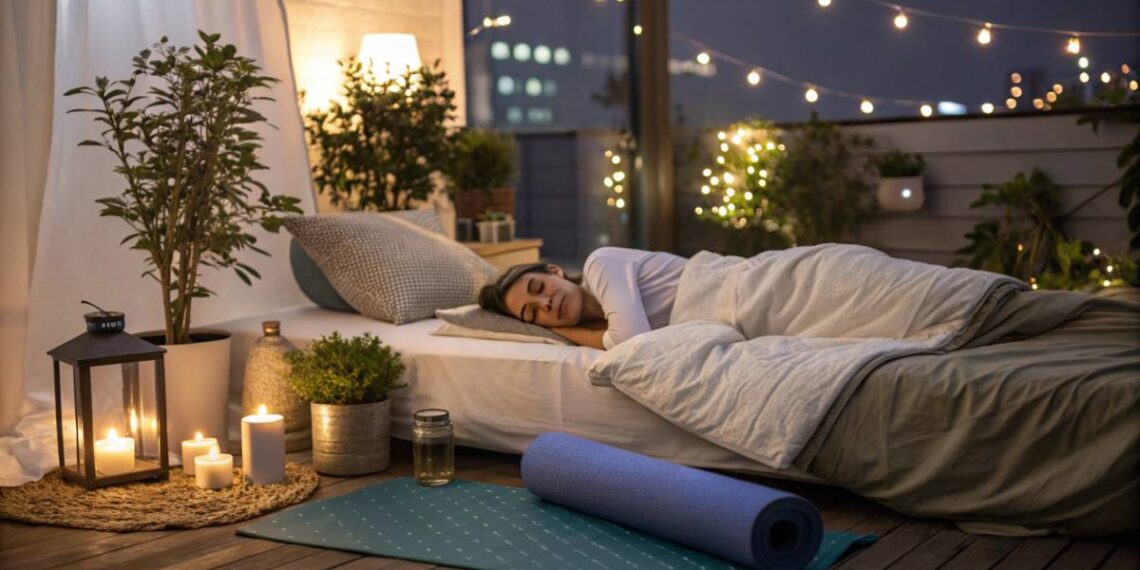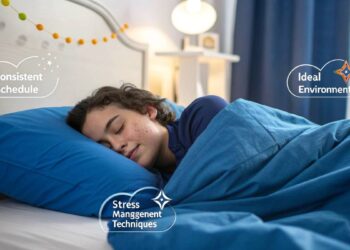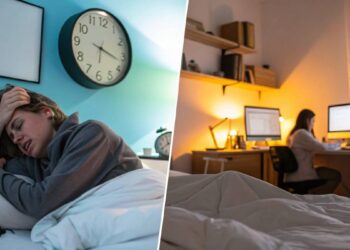Ever felt like your sleep is constantly interrupted by silent battles for each breath? Sleep apnea can turn peaceful nights into restless struggles, leaving you groggy and drained. But fear not—nature offers powerful remedies to reclaim your nights. From soothing yoga poses to dietary tweaks and herbal helpers, discover holistic approaches to tackle sleep apnea head-on. Let’s dive into effective, natural solutions that enhance your breathing, improve sleep quality, and rejuvenate your daily vitality.
Key Takeaways
- Understanding Sleep Apnea: Recognize the types and symptoms to identify sleep apnea effectively.
- Natural Remedies: Incorporate yoga, breathing exercises, and herbal supplements to alleviate symptoms.
- Lifestyle Adjustments: Adopt dietary changes, maintain a healthy weight, and establish a consistent sleep routine.
- When to Seek Medical Help: Know the signs that require professional intervention and available treatment options.
- Creating a Relaxing Environment: Optimize your bedroom for better sleep with temperature control, noise reduction, and calming scents.
Understanding Sleep Apnea
What is Sleep Apnea?
Sleep apnea’s like your breath taking an unscheduled coffee break while you’re snoozing. Folks with this hiccup in their sleep cycle often find themselves snoring like a lawnmower, waking up gasping like they’ve just outrun a bear, and feeling like they’ve been hit by a truck the next day. Knowing about this party-crasher is step one to tackling it head-on and exploring natural sleep fixes.
| Symptom | Description |
|---|---|
| Loud Snoring | Usually loud enough to startle dogs and roommates |
| Breathing Pauses | Times when breathing takes a breather |
| Gasping for Air | Feeling like you’ve swallowed a bug when waking up |
| Daytime Fatigue | Feeling pooped even after a full night |
| Morning Headaches | A morning hangover without the booze |
Types of Sleep Apnea
There are three flavors of sleep apnea:
- Obstructive Sleep Apnea (OSA): Think of it like a traffic jam in your throat – the muscles get lazy and block the road. While it likes to hang out with extra pounds, it ain’t picky and can visit anyone. Leave it unchecked, and you’re looking at a mixed bag of sleepless nights and health issues.
- Central Sleep Apnea (CSA): This one’s a bit more brainy – instead of your throat, it’s your brain that forgets to tell you to breathe. No roadblocks here, but it often hangs out with heart problems, strokes, or a lazy respiratory center.
- Complex Sleep Apnea Syndrome: AKA the overachiever, it’s when you get both OSA and CSA crashing your sleep party. Even when you think you’re getting help, this one keeps making breathing a puzzle.

Getting to know these types means you can pick the right battle plan, whether it’s treatment or going au naturel to show these symptoms the door.
For more tips on rounding up the sleep outlaws naturally, check out our guides on catching those ZZZs without dozing pills and the snazziest sleep aids nature can offer.
Natural Remedies for Sleep Apnea
Dealing with sleep apnea isn’t always easy, but nature’s got your back. Here, we’ll chat about some lifestyle tweaks and herbal buddies that might just hit the snooze button on sleep apnea symptoms.
On Natural Remedies: “Nature itself is the best physician.” – Hippocrates
Lifestyle Changes
Switching up simple daily routine bits can really make a difference. These tips might help you breathe a little easier at night.
- Trim Down: Keeping those pounds in check can ease up on sleep apnea. Extra weight, especially around the neck, can block the airflow. Eating right and breaking a sweat regularly is the way to go. Wanna know more on what to munch on for better sleep? Check out our read on diet for better sleep.
- Sleep Smart: If sleeping on your back messes with your snooze, try rolling to your side. This can keep those airways unblocked. More on creating a cozy sleep spot over at sleep-friendly bedroom.
- Cut Back on Partying: Both booze and smoking like to mess with throat muscles, leading to breathing hiccups. Cutting them out helps your sleep game big time.
- Set Your Clock: Having a regular bedtime can do wonders for your Zs. Need tips on crafting a killer sleep schedule? Peep our guide on bedtime routine for adults.
- Get Moving: Regular exercise gives a good kick to those breathing muscles and boosts your sleep. Curious about workouts that help sleep? Dive into exercise for better sleep.
| Lifestyle Change | What’s in it for you? |
|---|---|
| Trim Down | Airflow gets easier |
| Sleep Smart | Keeps the breathing passage open |
| Cut Back on Partying | Cuts down the relaxed throat muscles |
| Set Your Clock | Better sleep regularity |
| Get Moving | Strengthens breathing muscles, improves sleep quality |
Herbal Remedies
Herbs have got some magic up their sleeves for sleep apnea too. They blend well with lifestyle changes to kick up the quality of your snooze.
- Valerian Root: This little root helps keep the calm and boost your sleep. Great for tackling sleep issues like apnea. For a stash of more herbal stuff, take a peek at best natural sleep aids.
- Chamomile: A cup of chamomile tea can calm your nerves just right before bed. Sift through more soothing brews at herbal teas for sleep.
- Lavender: Lucky for you, lavender oil eases stress and jitters, improving sleep vibes. Give aromatherapy a whirl! More details can be found in essential oils for sleep.
Passionflower: It’s known for calming anxious thoughts and getting the mind to chill, translating to better zzzs.
| Herbal Remedy | Benefit |
|---|---|
| Valerian Root | Calms nerves, better quality sleep |
| Chamomile | Soothes, helps you unwind |
| Lavender | Cuts anxiety, reduces stress |
| Passionflower | Eases the mind, curbs anxiety |
Tacking these lifestyle moves and herbal helpers to your routine might just help take the edge off your sleep apnea. For more all-natural advice, don’t miss our guides on natural sleep solutions and how to fall asleep naturally.
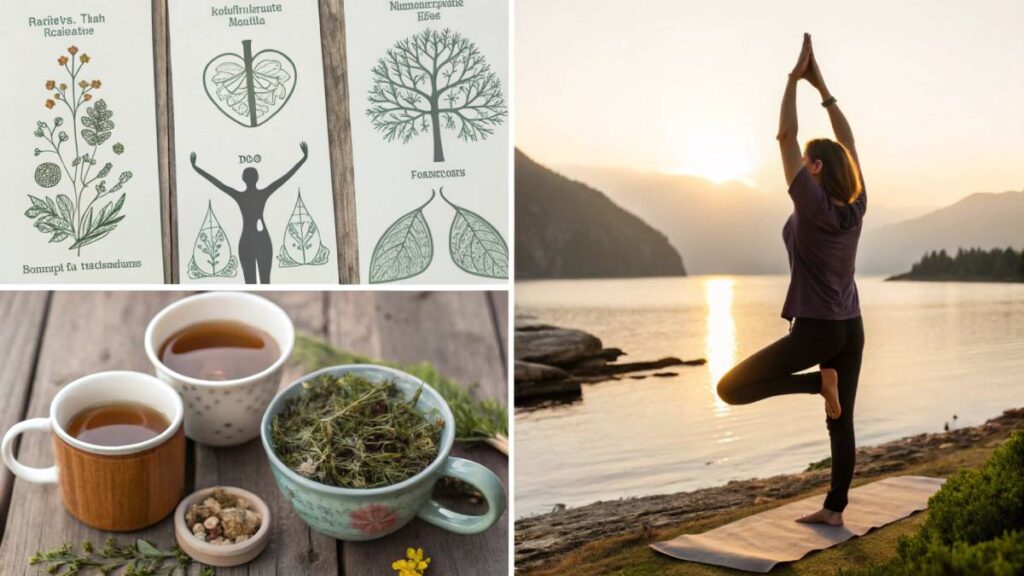
On Lifestyle Changes: “Take care of your body. It’s the only place you have to live.” – Jim Rohn
Diet and Sleep Apnea
Sleep apnea shakes up your night’s rest by messing with your breathing while you snooze. A little tweak to what you eat can be your ticket to dreamland by calming sleep apnea down a notch. Let’s chew the fat on how diet fits in.
Foods to Dodge
Some eats pack on pounds, stir up inflammation, or clog your nose, making sleep apnea worse. Keep tabs on what’s on your plate and keep these baddies to a minimum.
| Food Group | Examples |
|---|---|
| Greasy Grub | Chips, fried wings, doughnuts |
| Sweeties | Chocolate, fizzy drinks, cakes |
| Dairy | Milkshakes, string cheese, sundaes |
| Processed Carnivores | Salami, weiners, ham |
| Carbs Overload | Bagels, white pizza, muffins |
Foods to Munch On
Opt for eats that help you sleep tight and battle sleep apnea’s nastiness. It’s all about keeping the weight in check, turning down the inflammation, and upping your sleep game.
| Food Group | Examples |
|---|---|
| Lean Proteins | Grilled chicken, black beans, turkey |
| Good Grains | Quinoa, whole grain toast, oatmeal |
| Fruits and Veggies | Strawberries, spinach, broccoli |
| Good Fats | Guacamole, almonds, olive oil |
| Soothing Teas | Chamomile, mint, valerian brew |
For the 411 on how food connects to catching Z’s, peek at our tip sheet on dieting for stellar sleep. Stir in these chow choices with herbal helpers and life tweaks for a knockout bedtime game plan.
Sleep Hygiene Tips
Want a better snooze session? Tweaking your sleep habits can really make a difference, especially when dealing with sleep apnea. Let’s spruce up your sleep game by focusing on two important aspects: setting the right vibe and sticking to a routine.
Creating a Relaxing Environment
Turning your bedroom into a cozy sleep cave is where the magic happens. Here’s how to pull it off:
- Chill the Room Out: Aim for a comfy temperature around 60-67°F (15-19°C) that’ll lull you into dreamland.
- Shush the Noise: Block out disturbances with earplugs, a white noise gadget, or a trusty fan.
- Keep it Dark: Use blackout curtains or a sleep mask to banish unwelcome light.
- Sniff Some Scents: Dab a bit of lavender oil or other calming aromas to help knock you out. Sniff out more about essential oils for sleep.
Here’s a quick look at what works best:
| Thing to Tweak | Just Right Setting |
|---|---|
| Room Temp | 60-67°F (15-19°C) |
| Noise Level | Hushed or White Noise |
| Lighting | Dim or Blackout |
| Aromas | Lavender, Chamomile |
Need more bedroom makeover ideas? Check out sleep-friendly bedroom.
Establishing a Routine
Your body runs on habits—give it a heads-up that bedtime’s coming with these routine ideas:
- Stick to Sleep and Rise Times: Hit the hay and rise at the same time, all week long.
- Digital Ditch: Power down screens an hour before bed to let melatonin do its thing. Learn why with our digital detox sleep benefits.
- Chill Out Methods: Try reading, soaking in a warm bath, or meditating to wind down. More on that at meditation for sleep.
- Watch Your Evening Eats: Avoid big meals and caffeine before it’s lights out. Get the scoop on what munchies help at diet for better sleep.
Here’s a routine to inspire you:
| Time | What to Do |
|---|---|
| 8:30 PM | Flip through a book |
| 9:00 PM | Take a cozy bath |
| 9:30 PM | Unwind with calm exercises |
| 10:00 PM | Time for sleep |
For more on setting up a solid bedtime routine, check out bedtime routine for adults.
Get in the groove with these snooze tips to help ease sleep apnea and score some quality shut-eye. For more natural sleep boosts, take a peek at our natural sleep solutions.
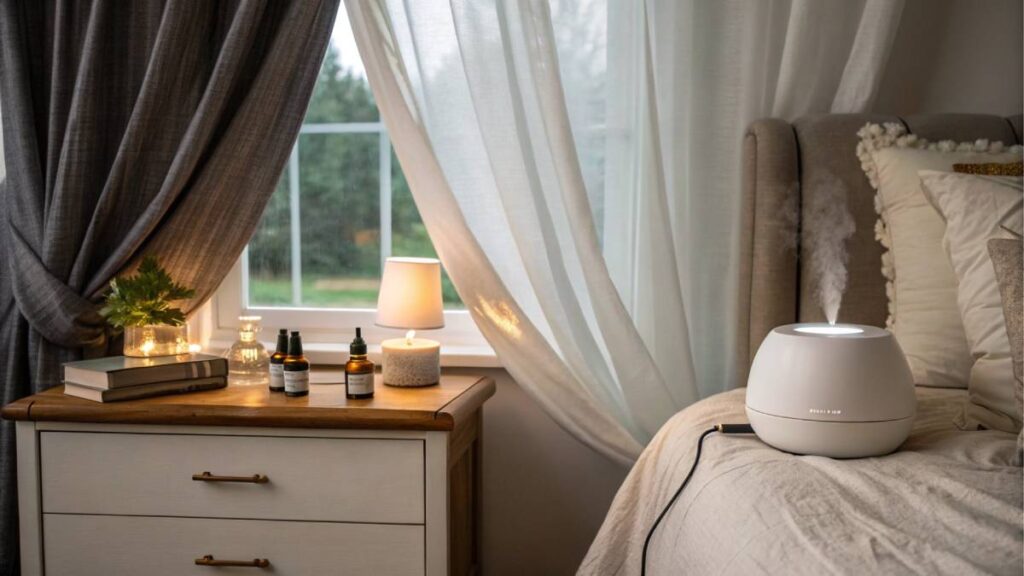
Breathing Exercises and Techniques
When it comes to snoozing with sleep apnea, getting those lungs working right is super important. A little focus on breathing can majorly boost your sleep game.
Why Breathe Right?
Breathing like a champ keeps your noggin and bod filled with plenty of oxygen for better shut-eye. Many folks with sleep apnea get the short end of the sleep stick with choppy breathing, which messes up their Zs and leaves them groggy all day. Breathing exercises can firm up those breathin’ muscles, helping you to hit the hay more consistently.
Tricks to Breathe Better
Ready to ease that sleepy-time breathing struggle? These breathing tricks might just be your new besties, helping clear airways, boost lung power, and catch more Zs.
1. Diaphragmatic Breathing
Also known as belly breathing, this one gives your diaphragm a workout and amps up your lung mojo.
- How to Give It a Go:
- Chill out on a comfy chair or bed.
- Rest one hand on your chest and the other on your belly.
- Suck in air through your nose, making sure your belly takes the spotlight by moving more than your chest.
- Let it out slowly through your mouth like you’re blowing out a candle.
2. Buteyko Breathing
This exercise helps dial down your breathing rate and levels up the carbon bits in your bloodstream.
- How to Try It:
- Sit like you’re on a coffee break and relax.
- Breathe in gently through your nose.
- Let the air out slowly just until it’s a tad uncomfortable.
- Hold your breath briefly, then resume normal breathing pattern.
3. Alternate Nostril Breathing
Hop on the yoga train with this one, also known as Nadi Shodhana. It makes sure both sides of your brain get their fair share of oxygen.
- How to Do It:
- Get yourself comfy seated.
- Use your thumb to shut the right nostril and breathe in through the left.
- Swap fingers, close the left nostril with your ring finger, breathe out the right side.
- Breathe in through the right nostril, switch, exhale out the left.
| Technique | Benefits |
|---|---|
| Diaphragmatic Breathing | Buffs up diaphragm, tunes up lung function |
| Buteyko Breathing | Lowers excess breaths, balances CO2 levels |
| Alternate Nostril Breathing | Evens out oxygen, chills your vibe |
Making these breathing tricks a habit could really shake things up for folks with sleep apnea. Wanna know more about getting good sleep the natural way? Check out our cool reads on natural sleep fixes and sipping herbal teas for sleep.
By giving these techniques a whirl, you’re on the road to better breathing and sweeter dreams. For extra ideas to jazz up your sleep, why not explore sleep meditation and sleepy yoga poses?
Yoga and Meditation for Sleep Apnea
Yoga’s got some magic when it comes to tackling sleep apnea. No need to dive into complicated procedures—just roll out your mat and breathe easy. These ancient practices aim to calm the mind, open up those airways, and help you catch some quality shut-eye.
Benefits of Yoga and Meditation
Yoga and meditation are more than just fancy breathing and stretching. They bring some solid perks for those wrestling with sleep apnea. Here are the highlights:
- Breathe Easier: Yoga won’t just have you breathing deeper and slower, it’ll get that oxygen flowing so you can say goodbye to those pesky apnea issues.
- Chill Out: Feeling stressed? Meditation’s your buddy here, kicking anxiety to the curb, which is a known troublemaker when it comes to sleep.
- Sleep Like a Baby: Find your zen and drift into dreamland faster, waking up feeling all refreshed and ready to tackle the day.
- Pump Up Those Lungs: Yoga’s got moves that toughen up those breathing muscles, which might just mean fewer apnea run-ins.
Curious about more relaxation tips? Check out our piece on meditation for sleep.
Specific Poses and Practices
Let’s talk specifics—here are some yoga poses and meditation tricks that folks with sleep apnea might find handy:
- Savasana (Corpse Pose): Lie back, relax, and let the calm wash over you, prepping you for a peaceful night’s slumber.
- Ujjayi Pranayama (Victorious Breath): It’s not just a fancy name—it’s a breathing drill that boosts your lung game.
- Balasana (Child’s Pose): Stretch out and feel those back and neck knots disappear—perfect for when sleep apnea’s got you in a twist.
- Viparita Karani (Legs Up the Wall Pose): Kick back and let go of the day’s stress, helping you drift off faster.
- Nadi Shodhana (Alternate Nostril Breathing): This one’s a game-changer for clearing stuffy noses and balancing your breath.
Want the full scoop on these poses? Jump to our detailed guide on yoga poses for sleep.
| Yoga Pose | What It Does |
|---|---|
| Savasana | Pure relaxation, stress-busting |
| Ujjayi Pranayama | Pumps up those lungs, lets air flow |
| Balasana | Eases that back and neck tension |
| Viparita Karani | Waves goodbye to stress, hello to calm |
| Nadi Shodhana | Opens up nasal passages, smooths out breathing |
Incorporate these yoga moves and meditation vibes into your daily groove to tackle sleep apnea head-on, and snooze better. For more sleep hacks, dig into our reads on natural sleep solutions and how to fall asleep naturally.
When to Ring Up the Doctor
Sure, your grandma’s chamomile tea and those socks with lavender can do wonders, but sometimes it’s time to let the pros take a swing at sleep apnea. A chat with a doc can clear things up and introduce you to the big leagues of treatment.

Chat Time with a Healthcare Pro
If snoring like a grizzly bear is a nightly occurrence, or constantly feeling like a zombie during the day, it’s time to hit pause and see the doc. Sleep apnea issues can mess with your life in a big way. Here’s when you ought to dial up your healthcare buddy:
- You’re snoring loud enough to wake up the neighbors
- You occasionally stop breathing as if trying to give your partner a heart attack
- Sleeping through the night but feel like you’ve pulled an all-nighter
- Napping at your desk when you shouldn’t be
- Waking up with a pounding headache and a Sahara-like mouth
- The sandman skips you, and you toss and turn all night
- Your mood’s as pleasant as a cat in a swimming pool
Sound familiar? Then it’s doc-o’clock. They’ll give you a clear diagnosis and steer you in the right direction. For more sleep tips, swing by our piece on natural sleep solutions.
What the Doc Might Suggest Next
The doc’s got a toolbox full of tricks to help beat sleep apnea. Here’s what they might pull out for you:
1. Steady Air Pump Gadget (CPAP):
- The MVP for obstructive sleep apnea. This nifty device keeps your airways wide open with a steady stream of air while you snooze.
2. Mouth Guard on Duty:
- A custom-fitted gadget to keep the throat space open.
- Great for folks who can’t handle CPAP.
3. Change Up Your Routine:
- Trim down on the pounds
- Put the cork back in the bottle
- Kick the smoking habit
- Combine these with natural hacks for best results.
4. Switch-it-up Sleeping:
- Train yourself to sleep on your side.
- Handy for those with back-sleep apnea issues.
5. Snip and Tuck:
- Sometimes they need to clear out some tissue or fix things up.
- Usually the option when nothing else works.
6. Join the Club:
- Meet people riding the same wave.
- Get a hand with the feels and the nitty-gritty.
| Treatment Route | How Well It Works | Good For |
|---|---|---|
| CPAP | Top-notch | Most obstructive sleep apnea cases |
| Oral Devices | Decent | Mild to moderate cases |
| Lifestyle Tweaks | It varies | Everyone |
| Positional Shift | Decent | Those with positional sleep apnea |
| Surgical Fix | Top-notch depending on the case | Severe or structural issues |
| Support Groups | It varies | Everyone |
For tailor-made advice and a treatment plan, have a word with your healthcare sidekick. Don’t miss out on other sleep wisdom we’ve got like best natural sleep aids and how to fall asleep naturally.
Main Tips
- Incorporate Daily Yoga: Practice specific yoga poses like Balasana and Ujjayi Pranayama to enhance breathing and relaxation.
- Adopt Breathing Exercises: Engage in diaphragmatic and alternate nostril breathing to improve lung function and reduce apnea episodes.
- Optimize Your Diet: Focus on anti-inflammatory foods and maintain a healthy weight to alleviate sleep apnea symptoms.
- Create a Sleep-Friendly Environment: Keep your bedroom cool, dark, and quiet to promote uninterrupted sleep.
- Establish a Consistent Sleep Routine: Go to bed and wake up at the same time daily to regulate your body’s internal clock.
Conclusion
Conquering sleep apnea doesn’t have to be an uphill battle marked solely by medical interventions. By embracing a holistic approach, you can significantly improve your sleep quality and overall well-being. Incorporating yoga poses like Balasana and Ujjayi Pranayama enhances your breathing and relaxes your body, while mindful dietary choices help reduce inflammation and maintain a healthy weight. Herbal remedies such as chamomile and valerian root offer natural calming effects, further supporting restful nights. Additionally, establishing a consistent sleep routine and optimizing your sleep environment create the perfect foundation for uninterrupted rest. Remember, while natural strategies are powerful, recognizing when to seek professional help is crucial for managing more severe cases. By blending these practices, you pave the way for peaceful slumbers and energized days, effectively tackling sleep apnea from multiple angles. Embrace these natural solutions and take proactive steps towards healthier, more restful sleep.
FAQs
What is sleep apnea and how does it affect my health?
Sleep apnea is a sleep disorder where breathing repeatedly stops and starts, leading to poor sleep quality and increased risk of heart disease, high blood pressure, and daytime fatigue.
What are the natural remedies for sleep apnea?
Natural remedies include yoga poses, breathing exercises, herbal supplements like chamomile and valerian root, dietary adjustments, and lifestyle changes such as maintaining a healthy weight and establishing a sleep routine.
When should I consult a doctor about sleep apnea?
Seek medical advice if you experience loud snoring, frequent breathing pauses during sleep, excessive daytime fatigue, morning headaches, or mood disturbances.
Can diet really impact sleep apnea symptoms?
Yes, a balanced diet that avoids inflammatory foods and supports a healthy weight can significantly reduce sleep apnea symptoms by easing airway obstruction and improving overall health.
How can yoga help with sleep apnea?
Yoga enhances lung capacity, strengthens breathing muscles, reduces stress, and promotes relaxation, all of which can alleviate sleep apnea symptoms and improve sleep quality.
Resources
- American Sleep Apnea Association
- National Institute of Neurological Disorders and Stroke: Sleep Apnea
- Mayo Clinic: Sleep Apnea
Final Thoughts
Navigating the challenges of sleep apnea requires a multifaceted approach that blends natural remedies with informed lifestyle choices. By integrating yoga, mindful breathing exercises, and herbal supplements into your daily routine, you can create a robust defense against disrupted sleep patterns. Additionally, making conscious dietary adjustments and fostering a tranquil sleep environment lay the groundwork for restorative rest. It’s essential to stay attuned to your body’s signals and consult healthcare professionals when necessary to ensure comprehensive management of the condition. Embracing these holistic strategies not only mitigates the symptoms of sleep apnea but also enhances your overall quality of life. Remember, the journey to better sleep is a blend of natural wisdom and proactive care—start implementing these tips today and wake up to energized, vibrant days.
Recommended Products
- CPAP Machine
- Essential for managing obstructive sleep apnea by maintaining open airways during sleep.
- Adjustable Pillow for Sleep Apnea
- Ergonomically designed to support the neck and prevent airway obstruction.
- Aromatherapy Diffuser with Essential Oils
- Create a calming sleep environment with soothing scents like lavender and chamomile.
- Yoga Mat for Home Practice
- Durable and comfortable mat ideal for practicing yoga poses that aid in sleep apnea.
- Herbal Tea Assortment Pack
- A selection of calming teas like chamomile and valerian root to promote relaxation before bed.
- White Noise Machine
- Blocks out disruptive sounds, helping to create a peaceful sleeping environment.
- Breathing Exercise Device
- Helps guide and monitor breathing patterns to improve respiratory function during sleep.
- Sleep Mask with Bluetooth Headphones
- Blocks out light and allows you to listen to calming sounds or guided meditations.

